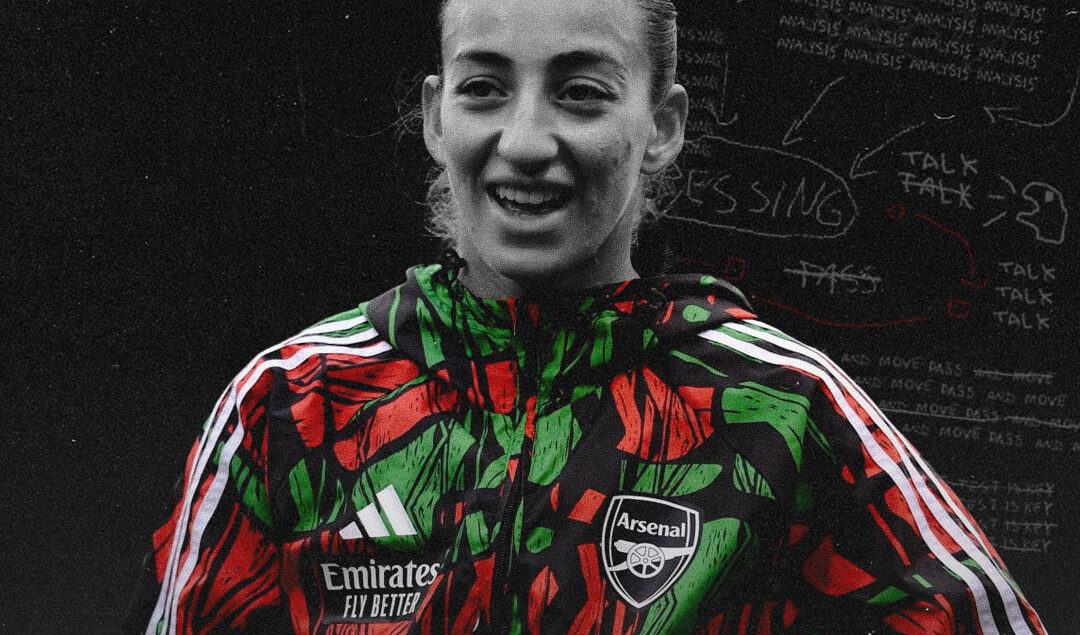Why Rosa Kafaji Could Inject a Much-Needed Creative Spark into Arsenal’s Attack
Arsenal Women’s start to the season has been far from impressive. Whilst they have managed to shake off a rocky introduction with four wins in their last five, the Gunners still find themselves one point behind Brighton, six behind Chelsea and seven behind league leaders Manchester City.
Arsenal’s 12 goals pale in comparison to Chelsea (23) and City (16), and it’s precisely this lack of finishing, coupled with a general absence of creativity in the final third, has raised serious doubts about Arsenal’s ability to challenge for the title—especially given the quality of their attacking lineup. It’s fair to say that key players like Beth Mead, Alessia Russo, Stina Blackstenius, and Mariona Caldentey have yet to hit their stride this season.
However, one player has yet to be given the chance to shine but could undoubtedly provide the creative spark Arsenal’s attack desperately needs. That player, of course, is summer signing Rosa Kafaji. The 21-year-old has every reason to feel frustrated about her limited game time, especially considering the absence of Victoria Pelova, who has been sidelined with an ACL injury since June.
Eidevall’s departure could present a real opportunity for Kafaji, who opened her account in English football in a 2-0 win at West Ham on October 20. With the team lacking confidence, the Swede may be exactly what’s needed to turn Arsenal’s fortunes around, if given the chance. In this scout report, we will explore why Rosa Kafaji is regarded as one of the most exciting prospects in women’s football and why she could be the creative spark Arsenal desperately need this season.
Player Profile
Name: Rosa Kafaji
Age: 21 years old
Club: Arsenal
Former Clubs: BK Häcken, AIK
Position: CAM
Secondary Position: LW, RW
Height: 169 cm
Foot: Both
Background info
Kafaji grew up in Stockholm and began playing football at the age of 8. In 2015, she joined the AIK youth system, where she made her professional debut four years later. During her time at AIK, Kafaji played a pivotal role in their promotion to the Damallsvenskan in 2020.
In 2022, she moved to BK Häcken, where she enjoyed two standout seasons, scoring 17 goals and playing a crucial role in their Champions League campaign, which saw the team reach the quarterfinals. By the summer of 2024, Kafaji signed a long-term contract with Arsenal, with many believing she was brought in to fill the void left by Vivianne Miedema after her seven-season tenure at the club.
Creativity and off-the-ball movement
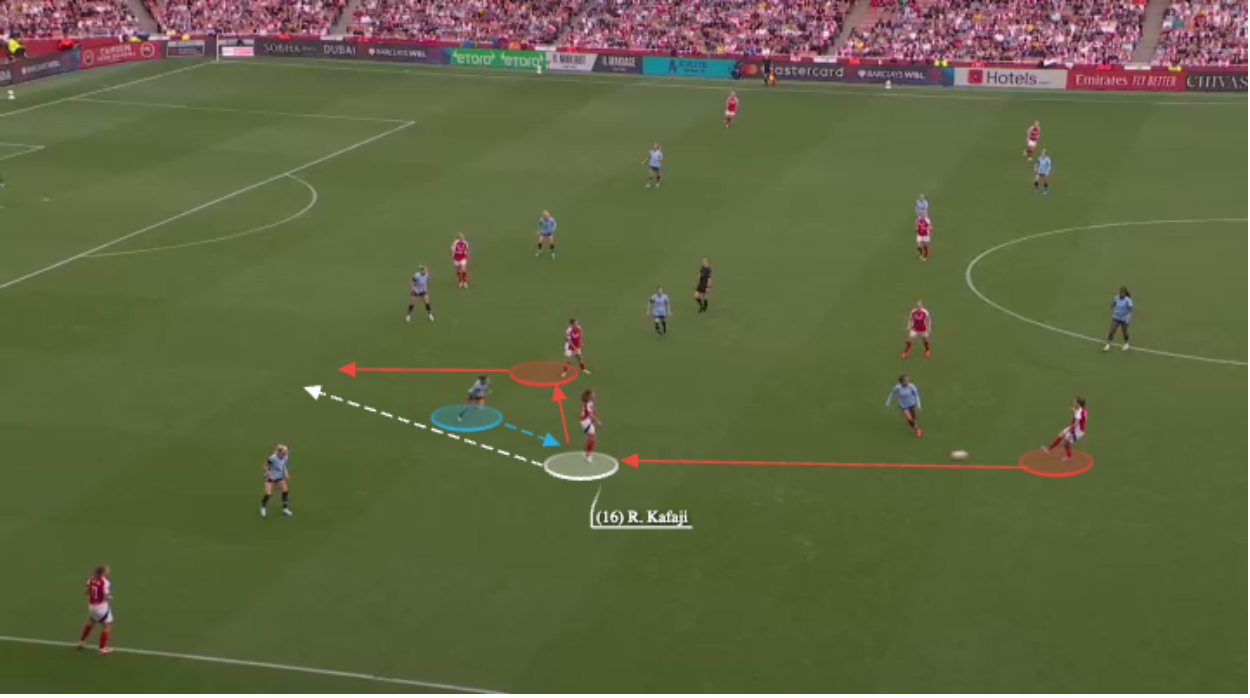
Kafaji has openly shared that Ronaldinho was her idol growing up, and she has aimed to model her game after his. His flair, creativity, and ability to bring joy to the game have clearly influenced her own style of play. The Swedish international has already shown a few sparks of attacking flair in her few substitute appearances for Arsenal. She likes to utilise quick flicks and subtle passes to link up with teammates.
In this instance, Kafaji executes a clever flicked pass to her teammate before quickly turning away from the pressing Manchester City player. She then makes a run into space, anticipating the return pass from her teammate. Moreover, Kafaji’s agility is one of her standout traits, allowing her to make sharp, quick movements in tight spaces or evade defenders who are marking her closely. This ability to manoeuvre swiftly not only helps her create space for herself but also opens up opportunities for her teammates.
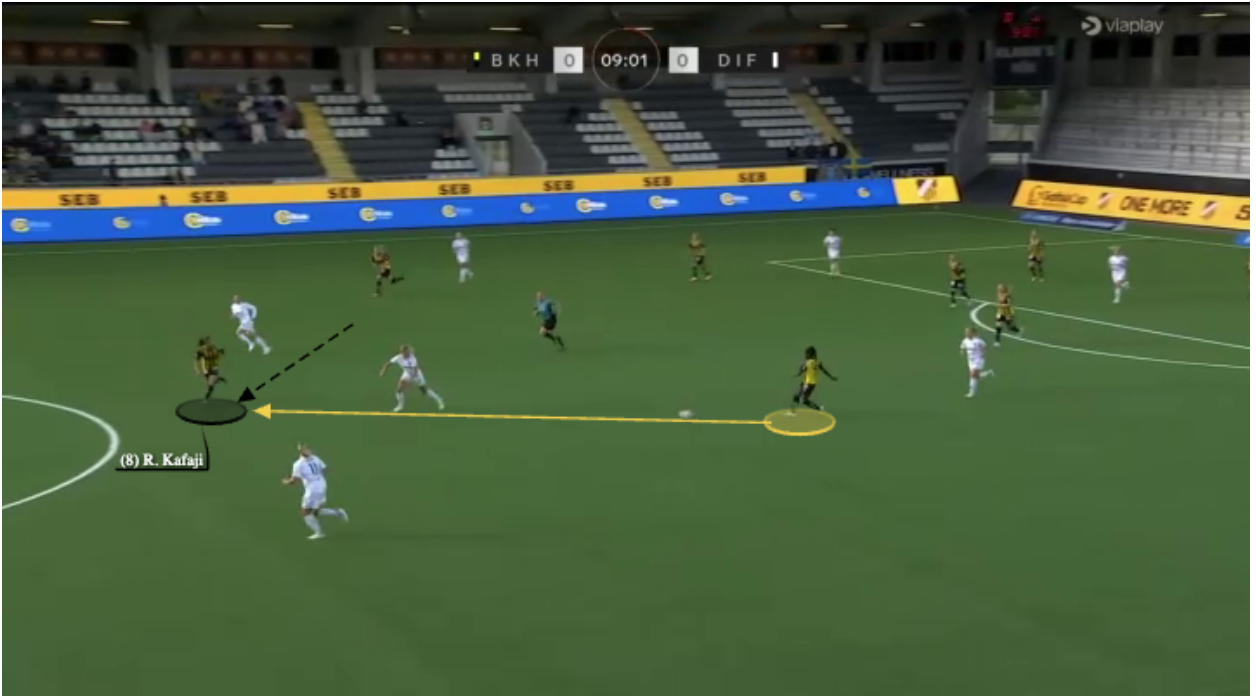
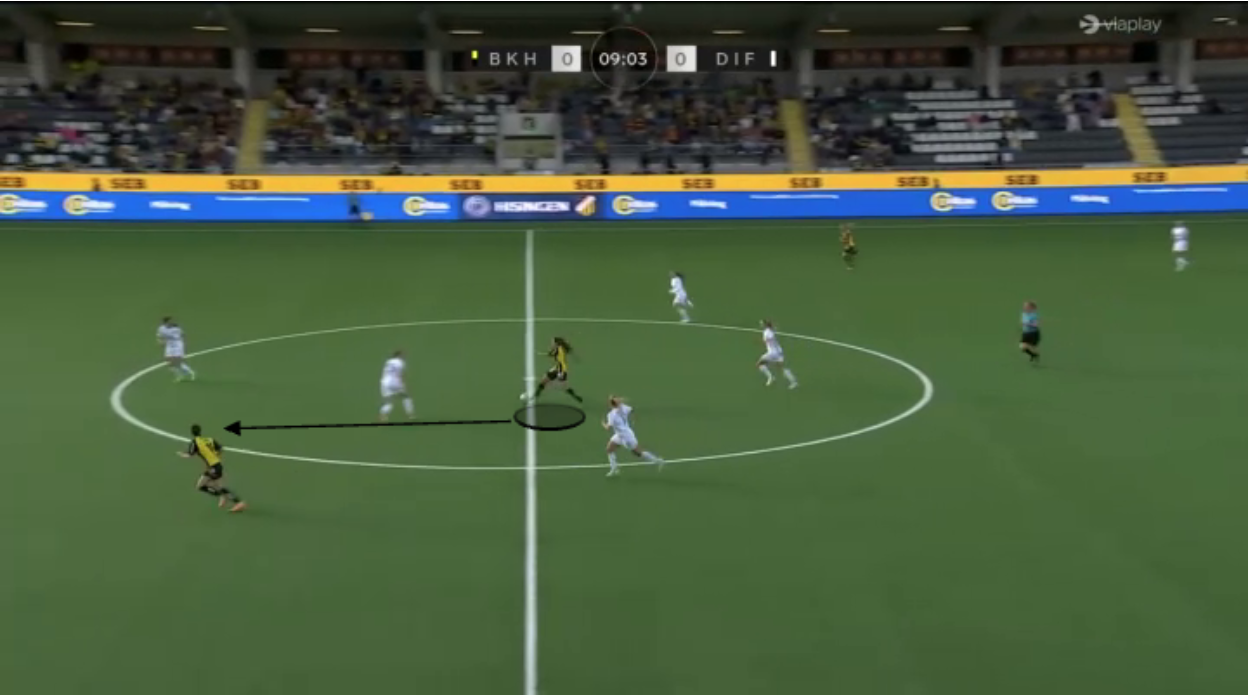
Kafaji’s ability to carry the ball through the centre of the pitch was a key asset during her time at Häcken, especially in counterattacking situations. With Pelova’s absence at Arsenal, her dynamic playstyle could fill a gap in their current midfield. Her sharp decision-making means she can break through the lines with pace and purpose, which is evident in the scenario depicted above.
Upon recovering possession, Kafaji’s quick recognition of the space and immediate movement to exploit it shows her tactical awareness. As she drives forward, she not only progresses play rapidly but also stretches the opposition’s defensive structure. What stands out is her timing; she doesn’t hold onto the ball unnecessarily. Instead, she swiftly assesses her options, making the right pass at the right moment.
In this case, her well-weighted pass into her teammate’s path ensures that Häcken can advance into the attacking third efficiently, continuing the momentum of the counterattack. This combination of ball-carrying ability and decision-making is precisely what makes her so effective, and why she has the potential to be a very valuable asset for Arsenal, especially in transition phases.
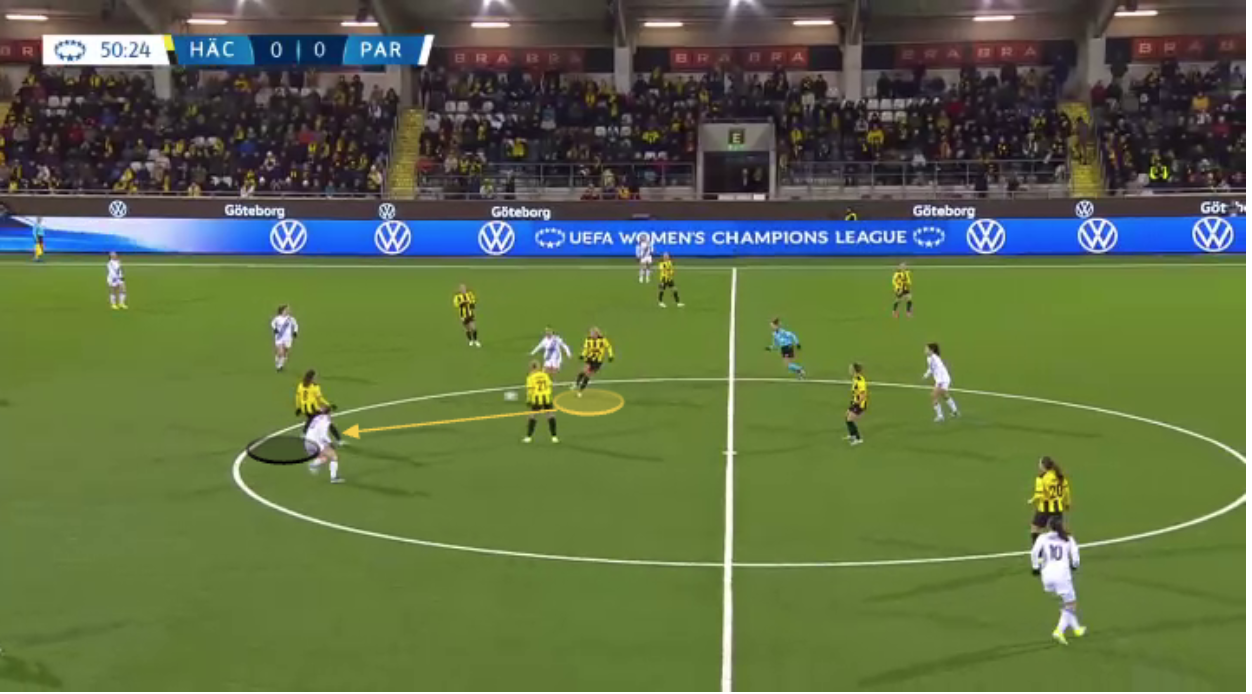
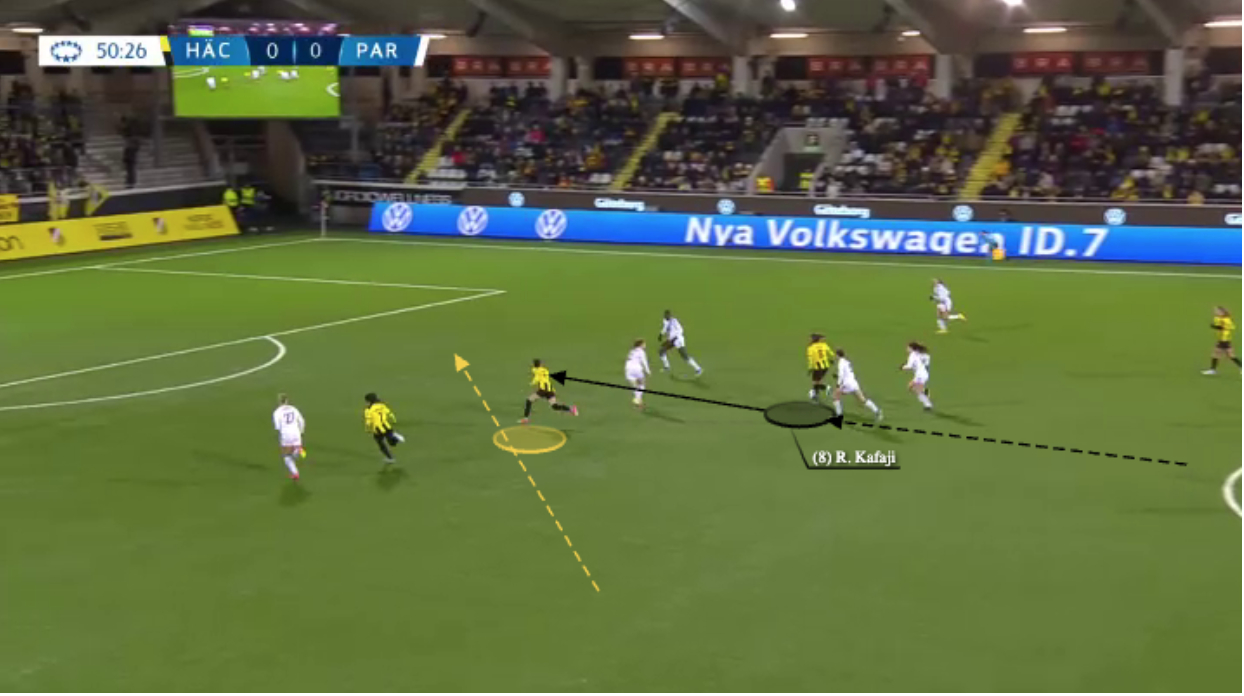
In this example, we see Kafaji pick up the ball in the centre of the pitch and drive forward before threading a through pass to her teammate. When watching the 21-year-old Swede, her awareness is one of the first things that catches the eye. She’s constantly scanning the field, always aware of her teammates’ positioning as well as that of her opponents’.
She is always ready to make short, sharp, subtle movements to receive the ball. On this occasion, as soon as her teammate shapes to pass the ball to her, Kafji makes a quick movement away from her opponent, creating just enough space for her to control the ball on the half turn and then drive into space.
Her performances during the 2024 season at Häcken reinforce how influential she can be in a playmaker role. Averaging 4.15 progressive passes, 2.38 progressive runs, and 8.29 dribbles per 90 minutes, Kafaji’s stats highlight her ability to push the play forward and create chances. This kind of playmaking ability is exactly what Arsenal could harness and utilise to great effect this season.
Shooting with either foot
Kafaji also provides a goal threat as she is very capable when executing shots from the edge of the area due to her ability to create space to get these shots off. Furthermore, the former AIK player has a wonderful ability to shoot with both feet, making her a lot less predictable to defenders. We can see in the scenario above, that Kafaji identifies a pocket of space outside the area and makes a run to receive the ball. She then hits a long shot (which flies into the top corner) with her left foot.
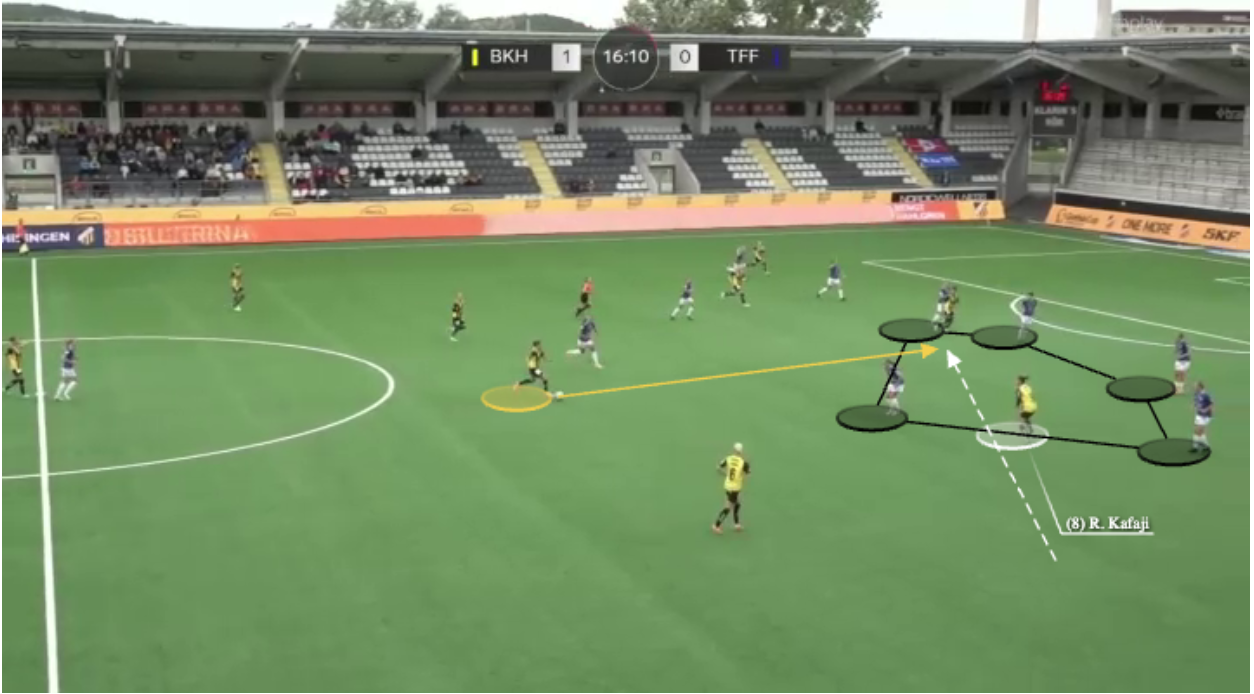
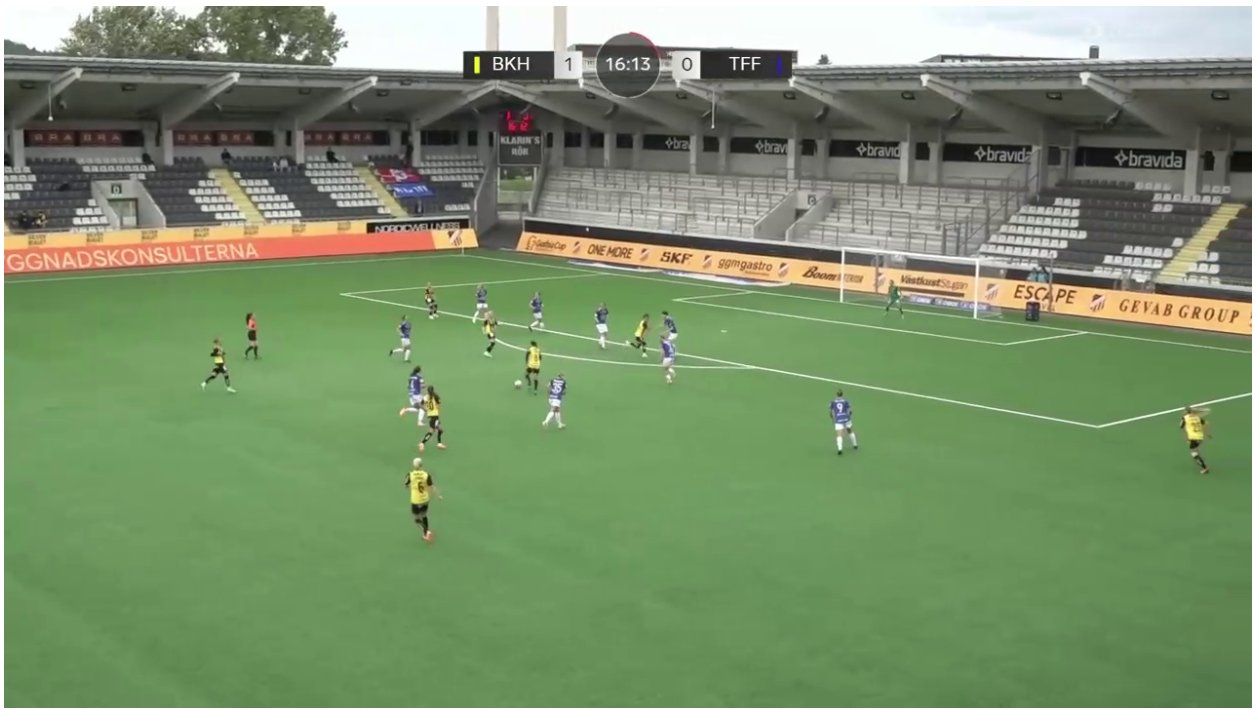
When a player is stronger on one foot, defenders can often anticipate which direction they will go or which side they will shoot from. However, Kafaji has a higher level of versatility therefore she is more difficult to defend against as she can confidently shift the ball to either foot and shoot without hesitation. Additionally, this means that Kafaji doesn’t need to rely on setting the ball up on her stronger side, which can waste crucial time in tight situations.
She can execute a quick strike under pressure, meaning she is able to optimise any angle or position in and around the box. This also results in a wider variety of finishing techniques. Whether it’s hitting a powerful shot with her laces, placing a shot across goal, or taking a snapshot with her ‘weaker’ foot, she has a range of different techniques at her disposal.
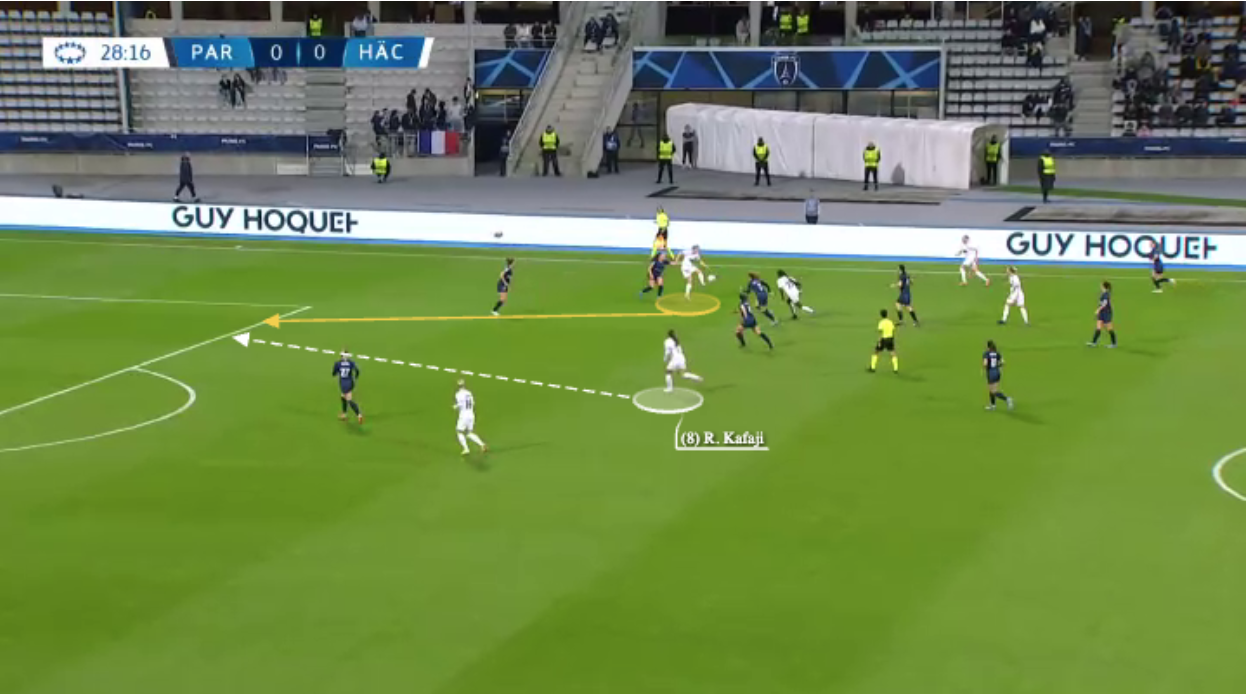
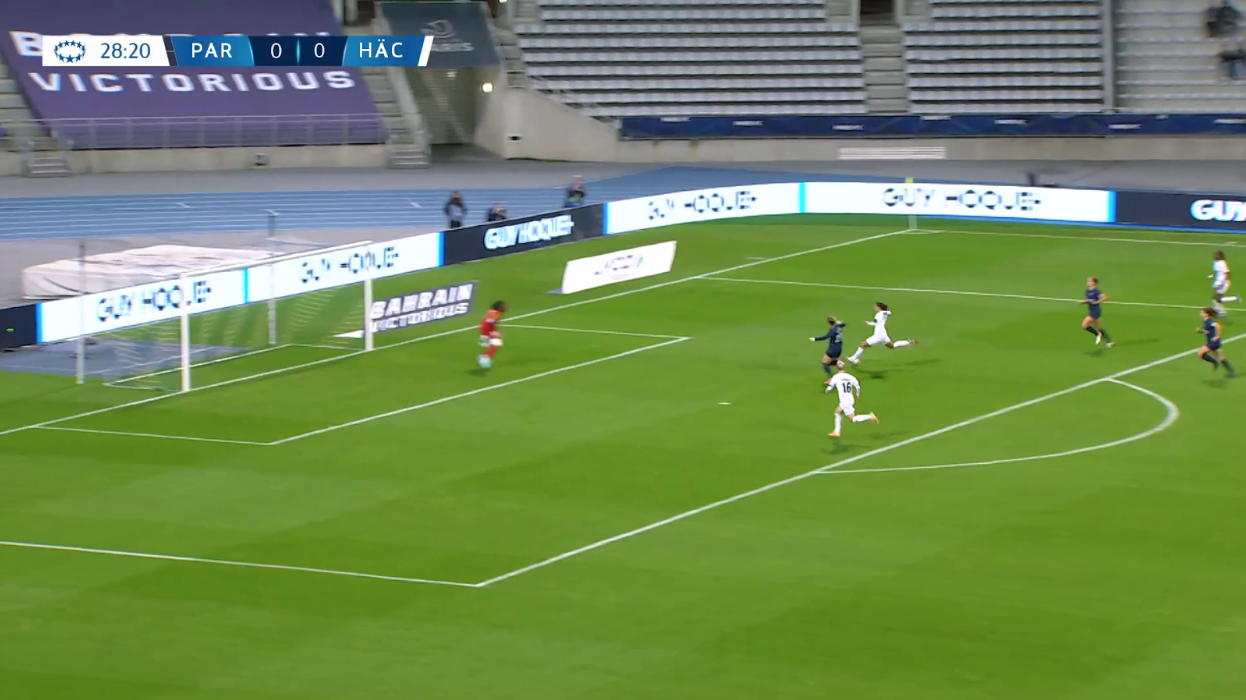
In the previous images, we saw Kafaji unleash a long-range shot with her left foot. Here, she makes one of her trademark runs in behind the opposition’s defensive line, showing her excellent movement off the ball. Once through, she fires a powerful drive across the goalkeeper with her right foot, showcasing her confidence and ability to shoot with either foot. We can see her ability to capitalise on chances from various angles and positions, making her a constant threat in front of goal.
Throughout the games she played for BK Häcken during the 2024 season, Kafaji averaged 0.5 goals per 90 from an xG of 0.56 per 90. She also averaged 3.48 shot per 90 with 46.8% hitting the target. Kafaji clearly has the potential to be a goal threat for Arsenal. In their 4-2-3-1 system, she could be deployed as a second striker, offering support to the main forward and adding more firepower in the final third.
Although she prefers to operate centrally, her versatility allows her to be used out wide as well. From there, she could cut inside to get into goalscoring positions, utilising her ability to shoot with both feet. This flexibility makes her a valuable attacking option, giving Arsenal more tactical variety and unpredictability in their forward play.
Tracking back
Kafaji is a willing runner and uses her athleticism to track opponents intelligently. Here, we can see Häcken in the defensive transition. The defensive line has fallen into a back four and the midfielders, including Kafaji, are moving into the defensive third.
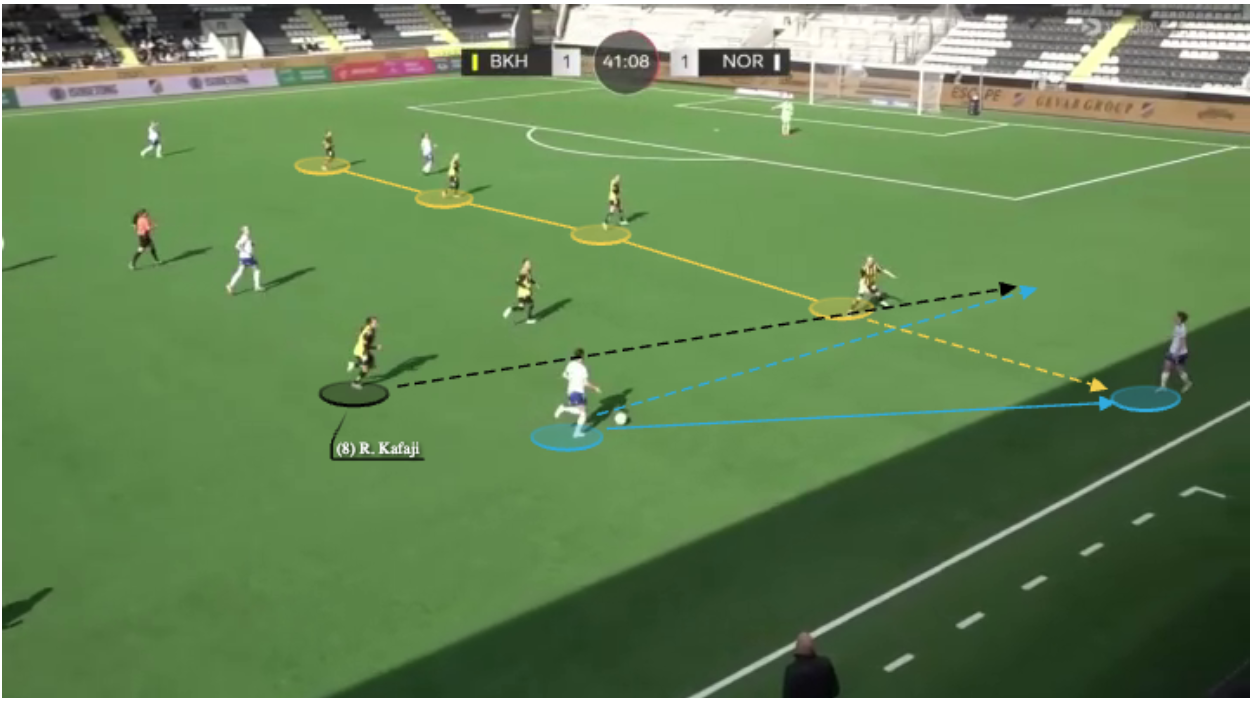
We can recognise that the opposition player in possession is going to play a pass out to her teammate, therefore attracting the Häcken defender out to close her down. Kafaji tracks the run of the opponent and is able to utilise her acceleration to ensure that the passing lane for the return pass is closed off, thwarting the attack.
By doing this, Rosa Kafaji helps to prevent counterattacks by staying alert to opponents making these runs. She disrupts the opposition’s attacking moves early, often forcing them to slow down or change their approach, providing her defensive teammates crucial time to reorganise.
Her presence also eases the pressure on the backline. When she tracks back diligently, she can close down space before the runner even reaches the defence. This reduces the likelihood of defenders being pulled out of position, which is key to maintaining a solid defensive shape.
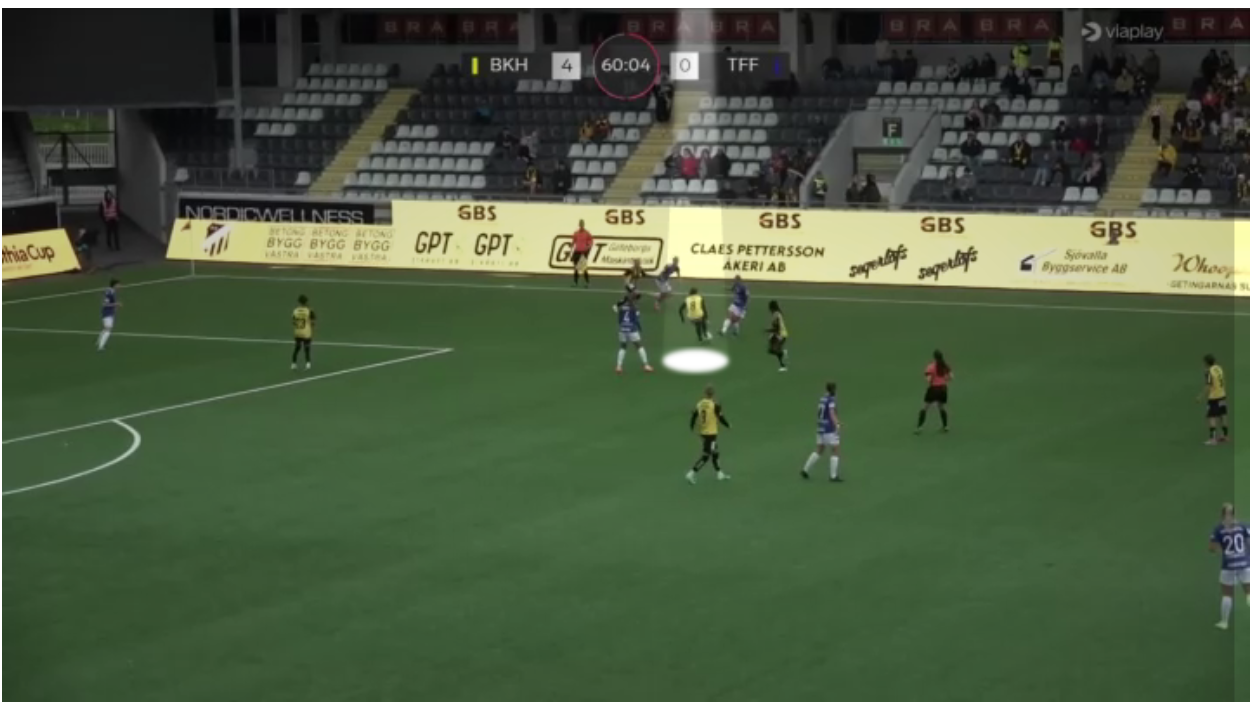
Furthermore, Kafaji’s propensity to find pockets of space is not limited to the attacking phase of play. She often recognises these tight spaces where the opposition is looking to play short, intricate passes and manages to get herself into an optimal position to make an interception.
In this instance, we can see here get in front of the opponent and make the interception, recovering possession for Häcken and allowing them to transition into attack. In the 2024 Damallsvenskan season, the new Arsenal recruit averaged 2.47 interceptions per 90 and 4.71 recoveries per 90.
Her willingness to work defensively speaks volumes about her dedication on the pitch. While she’s known for her attacking creativity and flair, Kafaji doesn’t shy away from the defensive responsibilities. She tracks back, competes in duels, recovers possession, and actively breaks down opposition plays, making her a well-rounded and invaluable asset.
Conclusion
It’s been a tough start to the season for Arsenal, whose lack of cutting edge in the final third is a growing concern for fans, and it’s an issue the next manager will need to address quickly. The solution though, might already be sitting on the bench in Rosa Kafaji.
Despite her limited game time so far, we know she has the potential to make a real difference. The young Swede is brimming with talent and offers something Arsenal have been missing—a player who can create chances out of nothing and inject some much-needed flair into the attack. She’s capable of turning games with her vision, technical skill, and ability to drive the team forward.
While it’s understandable that integrating new players takes time, Kafaji’s performances in Sweden and her versatility make a strong case for more minutes. If given the opportunity, she could be the spark Arsenal need to reignite their season and push for success on both domestic and European fronts.
By: Beth Limb / @bethlimb
Featured Image: @GabFoligno / Alex Burstow / Arsenal FC
